EDU30068 Teaching Early Reading: Assessments, Phonics & Vocabulary
VerifiedAdded on 2023/06/07
|12
|3938
|368
Portfolio
AI Summary
This portfolio provides a comprehensive analysis of early reading assessments and teaching strategies, focusing on phonemic awareness, phonics, fluency, vocabulary, and comprehension. It includes a miscue analysis of a student's reading, identifying challenges with letter sounds and comprehension. The report critically discusses various reading assessment methods, including running records, and emphasizes the importance of an inclusive approach to early reading development. Furthermore, it explores strategies for supporting and extending children’s learning of phonics and reading vocabulary, and presents a lesson plan designed to improve students' reading fluency. The analysis highlights the need for targeted interventions to address specific reading difficulties and promote effective early literacy skills. Desklib offers a wealth of similar educational resources for students.
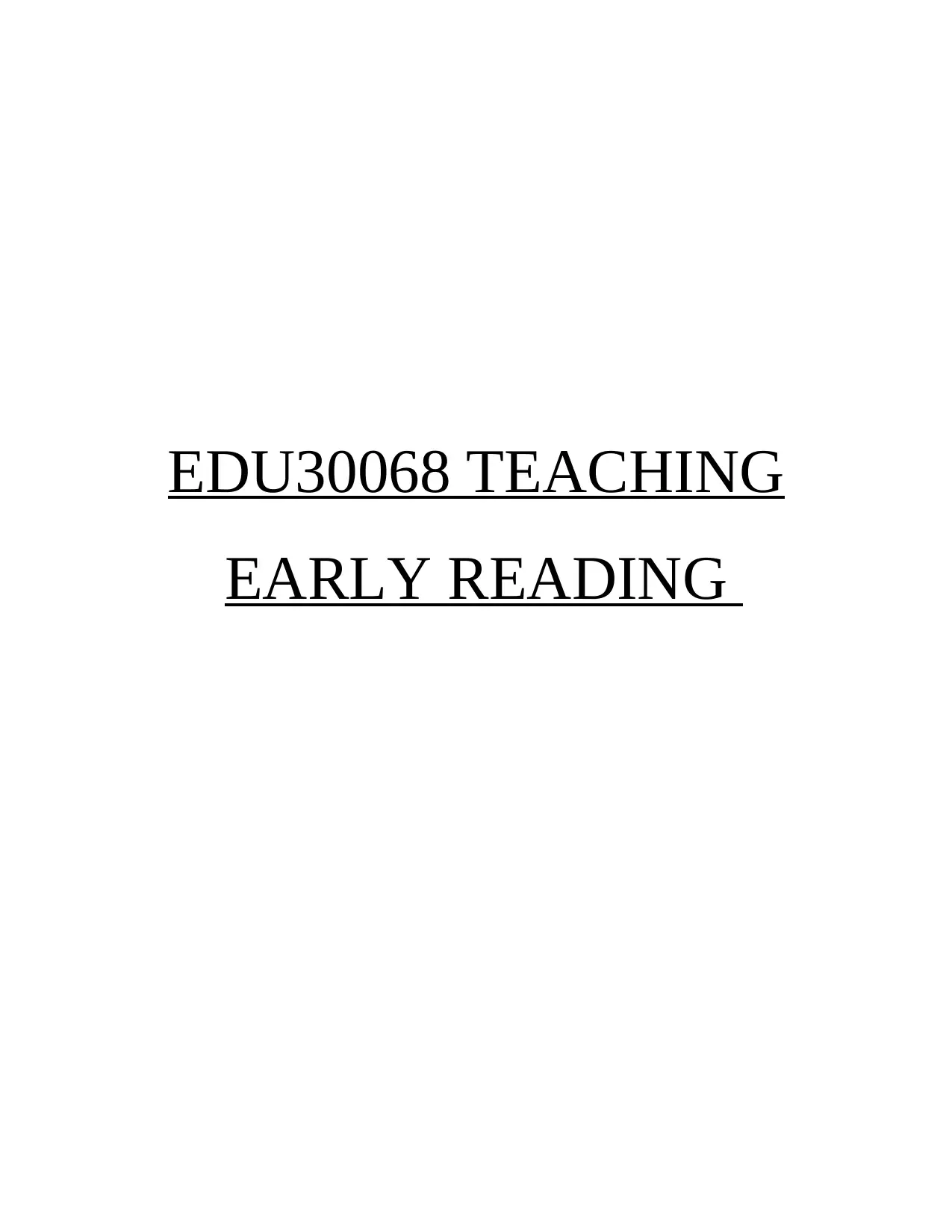
EDU30068 TEACHING
EARLY READING
EARLY READING
Paraphrase This Document
Need a fresh take? Get an instant paraphrase of this document with our AI Paraphraser
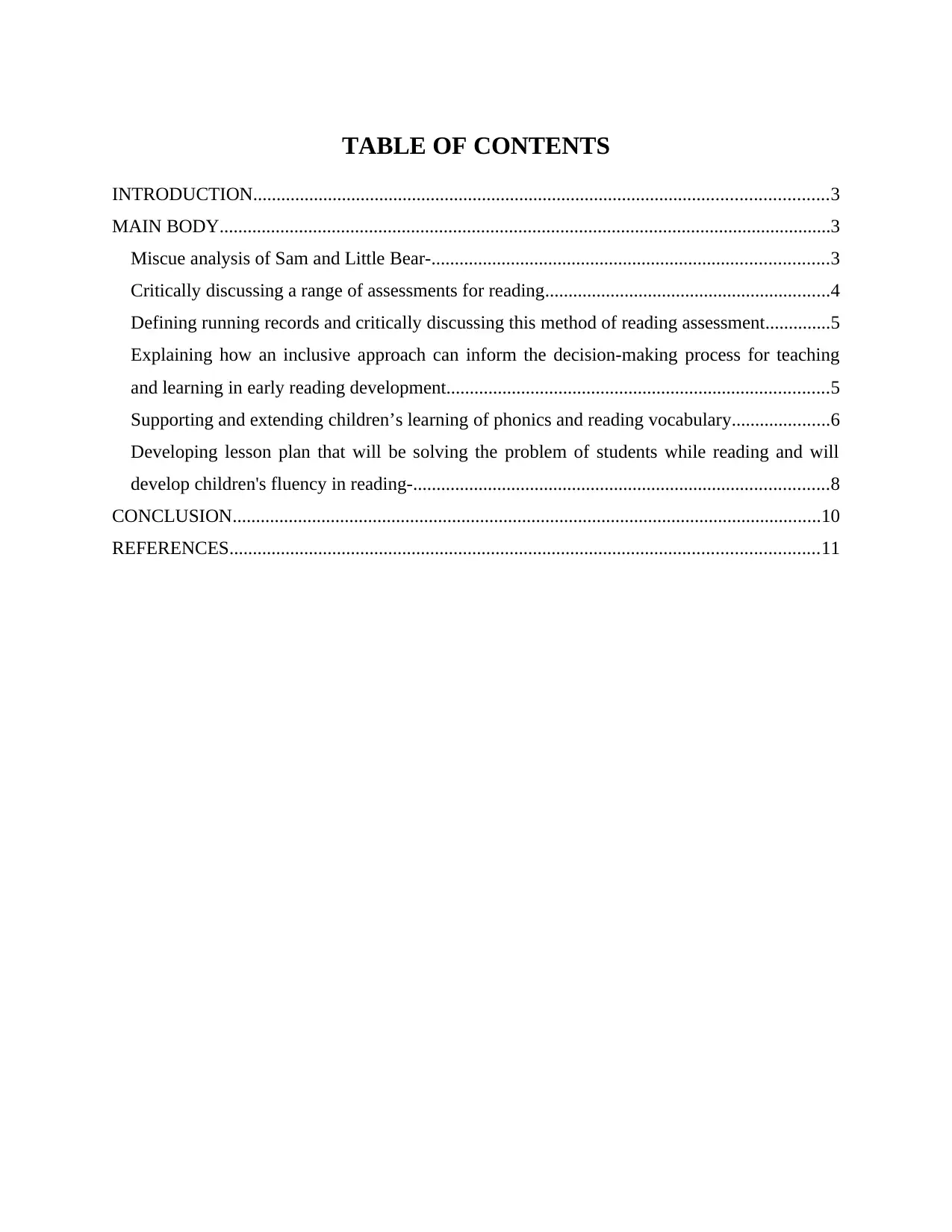
TABLE OF CONTENTS
INTRODUCTION...........................................................................................................................3
MAIN BODY...................................................................................................................................3
Miscue analysis of Sam and Little Bear-.....................................................................................3
Critically discussing a range of assessments for reading.............................................................4
Defining running records and critically discussing this method of reading assessment..............5
Explaining how an inclusive approach can inform the decision-making process for teaching
and learning in early reading development..................................................................................5
Supporting and extending children’s learning of phonics and reading vocabulary.....................6
Developing lesson plan that will be solving the problem of students while reading and will
develop children's fluency in reading-.........................................................................................8
CONCLUSION..............................................................................................................................10
REFERENCES..............................................................................................................................11
INTRODUCTION...........................................................................................................................3
MAIN BODY...................................................................................................................................3
Miscue analysis of Sam and Little Bear-.....................................................................................3
Critically discussing a range of assessments for reading.............................................................4
Defining running records and critically discussing this method of reading assessment..............5
Explaining how an inclusive approach can inform the decision-making process for teaching
and learning in early reading development..................................................................................5
Supporting and extending children’s learning of phonics and reading vocabulary.....................6
Developing lesson plan that will be solving the problem of students while reading and will
develop children's fluency in reading-.........................................................................................8
CONCLUSION..............................................................................................................................10
REFERENCES..............................................................................................................................11
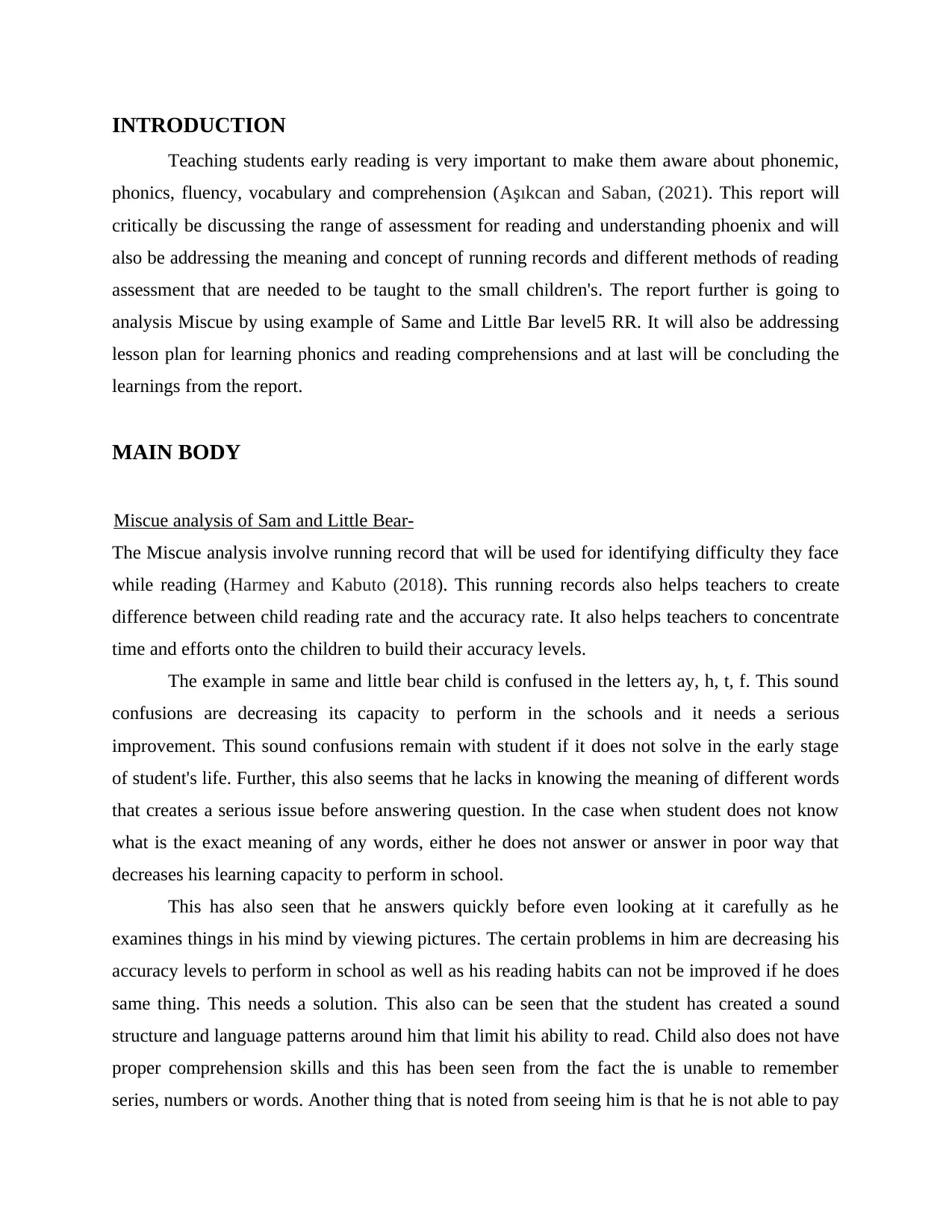
INTRODUCTION
Teaching students early reading is very important to make them aware about phonemic,
phonics, fluency, vocabulary and comprehension (Aşıkcan and Saban, (2021). This report will
critically be discussing the range of assessment for reading and understanding phoenix and will
also be addressing the meaning and concept of running records and different methods of reading
assessment that are needed to be taught to the small children's. The report further is going to
analysis Miscue by using example of Same and Little Bar level5 RR. It will also be addressing
lesson plan for learning phonics and reading comprehensions and at last will be concluding the
learnings from the report.
MAIN BODY
Miscue analysis of Sam and Little Bear-
The Miscue analysis involve running record that will be used for identifying difficulty they face
while reading (Harmey and Kabuto (2018). This running records also helps teachers to create
difference between child reading rate and the accuracy rate. It also helps teachers to concentrate
time and efforts onto the children to build their accuracy levels.
The example in same and little bear child is confused in the letters ay, h, t, f. This sound
confusions are decreasing its capacity to perform in the schools and it needs a serious
improvement. This sound confusions remain with student if it does not solve in the early stage
of student's life. Further, this also seems that he lacks in knowing the meaning of different words
that creates a serious issue before answering question. In the case when student does not know
what is the exact meaning of any words, either he does not answer or answer in poor way that
decreases his learning capacity to perform in school.
This has also seen that he answers quickly before even looking at it carefully as he
examines things in his mind by viewing pictures. The certain problems in him are decreasing his
accuracy levels to perform in school as well as his reading habits can not be improved if he does
same thing. This needs a solution. This also can be seen that the student has created a sound
structure and language patterns around him that limit his ability to read. Child also does not have
proper comprehension skills and this has been seen from the fact the is unable to remember
series, numbers or words. Another thing that is noted from seeing him is that he is not able to pay
Teaching students early reading is very important to make them aware about phonemic,
phonics, fluency, vocabulary and comprehension (Aşıkcan and Saban, (2021). This report will
critically be discussing the range of assessment for reading and understanding phoenix and will
also be addressing the meaning and concept of running records and different methods of reading
assessment that are needed to be taught to the small children's. The report further is going to
analysis Miscue by using example of Same and Little Bar level5 RR. It will also be addressing
lesson plan for learning phonics and reading comprehensions and at last will be concluding the
learnings from the report.
MAIN BODY
Miscue analysis of Sam and Little Bear-
The Miscue analysis involve running record that will be used for identifying difficulty they face
while reading (Harmey and Kabuto (2018). This running records also helps teachers to create
difference between child reading rate and the accuracy rate. It also helps teachers to concentrate
time and efforts onto the children to build their accuracy levels.
The example in same and little bear child is confused in the letters ay, h, t, f. This sound
confusions are decreasing its capacity to perform in the schools and it needs a serious
improvement. This sound confusions remain with student if it does not solve in the early stage
of student's life. Further, this also seems that he lacks in knowing the meaning of different words
that creates a serious issue before answering question. In the case when student does not know
what is the exact meaning of any words, either he does not answer or answer in poor way that
decreases his learning capacity to perform in school.
This has also seen that he answers quickly before even looking at it carefully as he
examines things in his mind by viewing pictures. The certain problems in him are decreasing his
accuracy levels to perform in school as well as his reading habits can not be improved if he does
same thing. This needs a solution. This also can be seen that the student has created a sound
structure and language patterns around him that limit his ability to read. Child also does not have
proper comprehension skills and this has been seen from the fact the is unable to remember
series, numbers or words. Another thing that is noted from seeing him is that he is not able to pay
⊘ This is a preview!⊘
Do you want full access?
Subscribe today to unlock all pages.

Trusted by 1+ million students worldwide
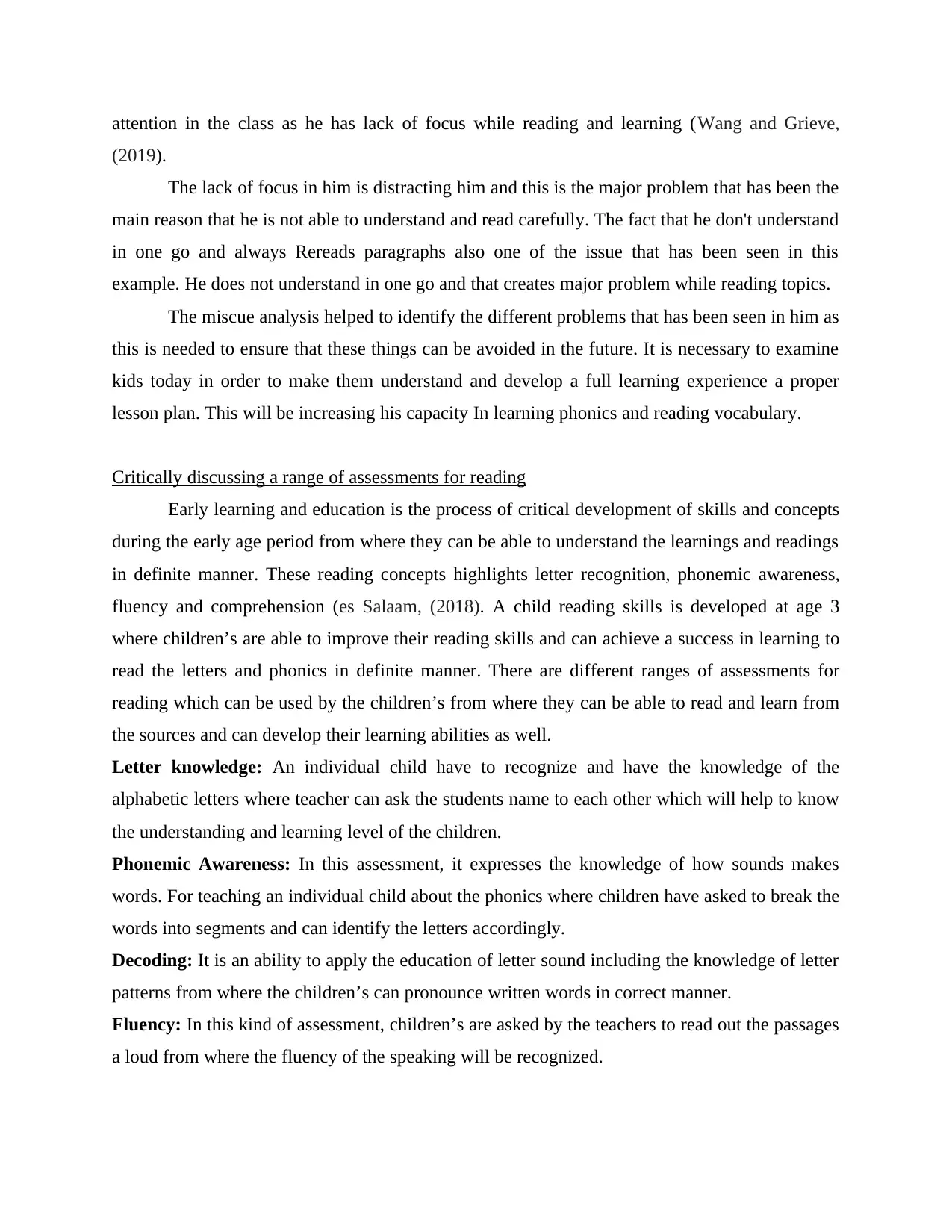
attention in the class as he has lack of focus while reading and learning (Wang and Grieve,
(2019).
The lack of focus in him is distracting him and this is the major problem that has been the
main reason that he is not able to understand and read carefully. The fact that he don't understand
in one go and always Rereads paragraphs also one of the issue that has been seen in this
example. He does not understand in one go and that creates major problem while reading topics.
The miscue analysis helped to identify the different problems that has been seen in him as
this is needed to ensure that these things can be avoided in the future. It is necessary to examine
kids today in order to make them understand and develop a full learning experience a proper
lesson plan. This will be increasing his capacity In learning phonics and reading vocabulary.
Critically discussing a range of assessments for reading
Early learning and education is the process of critical development of skills and concepts
during the early age period from where they can be able to understand the learnings and readings
in definite manner. These reading concepts highlights letter recognition, phonemic awareness,
fluency and comprehension (es Salaam, (2018). A child reading skills is developed at age 3
where children’s are able to improve their reading skills and can achieve a success in learning to
read the letters and phonics in definite manner. There are different ranges of assessments for
reading which can be used by the children’s from where they can be able to read and learn from
the sources and can develop their learning abilities as well.
Letter knowledge: An individual child have to recognize and have the knowledge of the
alphabetic letters where teacher can ask the students name to each other which will help to know
the understanding and learning level of the children.
Phonemic Awareness: In this assessment, it expresses the knowledge of how sounds makes
words. For teaching an individual child about the phonics where children have asked to break the
words into segments and can identify the letters accordingly.
Decoding: It is an ability to apply the education of letter sound including the knowledge of letter
patterns from where the children’s can pronounce written words in correct manner.
Fluency: In this kind of assessment, children’s are asked by the teachers to read out the passages
a loud from where the fluency of the speaking will be recognized.
(2019).
The lack of focus in him is distracting him and this is the major problem that has been the
main reason that he is not able to understand and read carefully. The fact that he don't understand
in one go and always Rereads paragraphs also one of the issue that has been seen in this
example. He does not understand in one go and that creates major problem while reading topics.
The miscue analysis helped to identify the different problems that has been seen in him as
this is needed to ensure that these things can be avoided in the future. It is necessary to examine
kids today in order to make them understand and develop a full learning experience a proper
lesson plan. This will be increasing his capacity In learning phonics and reading vocabulary.
Critically discussing a range of assessments for reading
Early learning and education is the process of critical development of skills and concepts
during the early age period from where they can be able to understand the learnings and readings
in definite manner. These reading concepts highlights letter recognition, phonemic awareness,
fluency and comprehension (es Salaam, (2018). A child reading skills is developed at age 3
where children’s are able to improve their reading skills and can achieve a success in learning to
read the letters and phonics in definite manner. There are different ranges of assessments for
reading which can be used by the children’s from where they can be able to read and learn from
the sources and can develop their learning abilities as well.
Letter knowledge: An individual child have to recognize and have the knowledge of the
alphabetic letters where teacher can ask the students name to each other which will help to know
the understanding and learning level of the children.
Phonemic Awareness: In this assessment, it expresses the knowledge of how sounds makes
words. For teaching an individual child about the phonics where children have asked to break the
words into segments and can identify the letters accordingly.
Decoding: It is an ability to apply the education of letter sound including the knowledge of letter
patterns from where the children’s can pronounce written words in correct manner.
Fluency: In this kind of assessment, children’s are asked by the teachers to read out the passages
a loud from where the fluency of the speaking will be recognized.
Paraphrase This Document
Need a fresh take? Get an instant paraphrase of this document with our AI Paraphraser
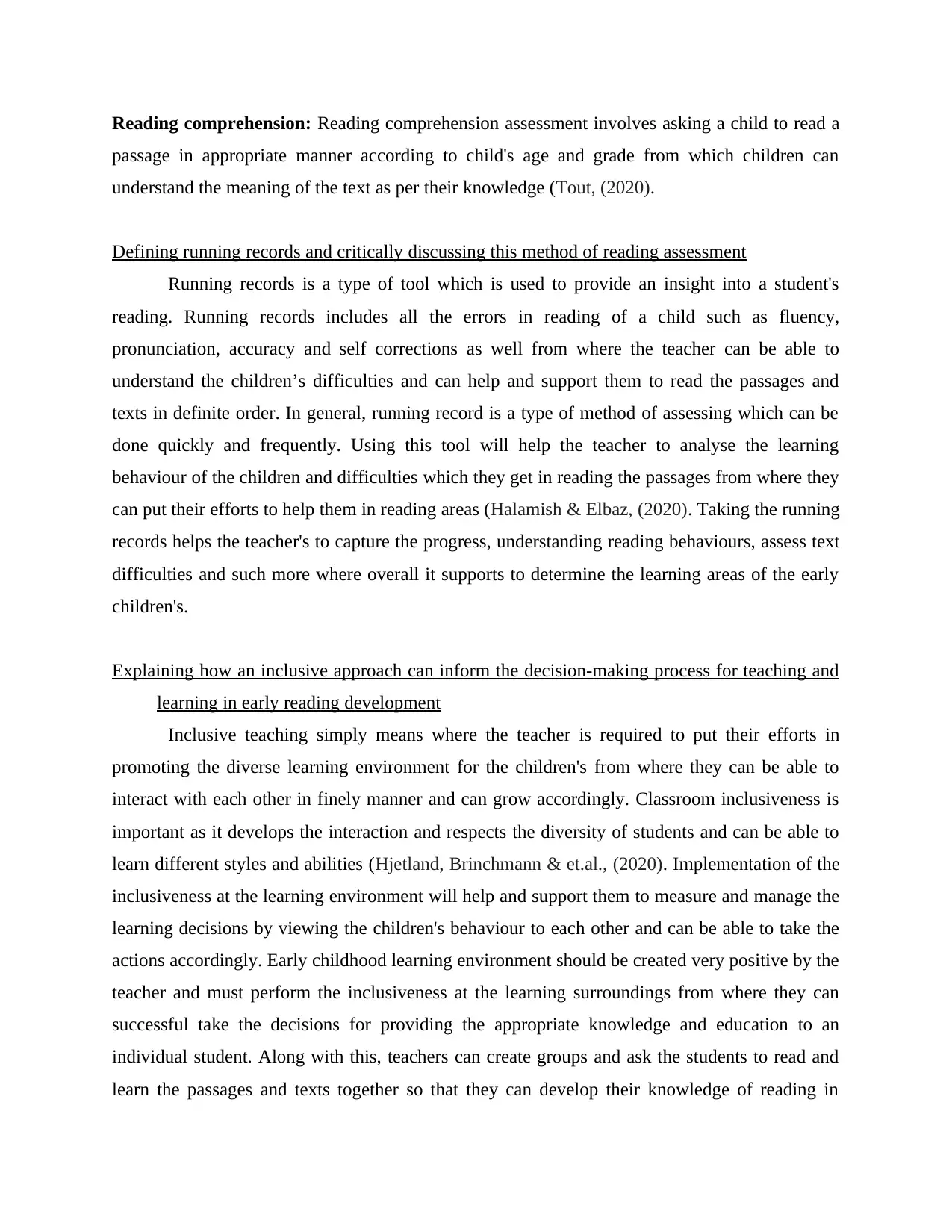
Reading comprehension: Reading comprehension assessment involves asking a child to read a
passage in appropriate manner according to child's age and grade from which children can
understand the meaning of the text as per their knowledge (Tout, (2020).
Defining running records and critically discussing this method of reading assessment
Running records is a type of tool which is used to provide an insight into a student's
reading. Running records includes all the errors in reading of a child such as fluency,
pronunciation, accuracy and self corrections as well from where the teacher can be able to
understand the children’s difficulties and can help and support them to read the passages and
texts in definite order. In general, running record is a type of method of assessing which can be
done quickly and frequently. Using this tool will help the teacher to analyse the learning
behaviour of the children and difficulties which they get in reading the passages from where they
can put their efforts to help them in reading areas (Halamish & Elbaz, (2020). Taking the running
records helps the teacher's to capture the progress, understanding reading behaviours, assess text
difficulties and such more where overall it supports to determine the learning areas of the early
children's.
Explaining how an inclusive approach can inform the decision-making process for teaching and
learning in early reading development
Inclusive teaching simply means where the teacher is required to put their efforts in
promoting the diverse learning environment for the children's from where they can be able to
interact with each other in finely manner and can grow accordingly. Classroom inclusiveness is
important as it develops the interaction and respects the diversity of students and can be able to
learn different styles and abilities (Hjetland, Brinchmann & et.al., (2020). Implementation of the
inclusiveness at the learning environment will help and support them to measure and manage the
learning decisions by viewing the children's behaviour to each other and can be able to take the
actions accordingly. Early childhood learning environment should be created very positive by the
teacher and must perform the inclusiveness at the learning surroundings from where they can
successful take the decisions for providing the appropriate knowledge and education to an
individual student. Along with this, teachers can create groups and ask the students to read and
learn the passages and texts together so that they can develop their knowledge of reading in
passage in appropriate manner according to child's age and grade from which children can
understand the meaning of the text as per their knowledge (Tout, (2020).
Defining running records and critically discussing this method of reading assessment
Running records is a type of tool which is used to provide an insight into a student's
reading. Running records includes all the errors in reading of a child such as fluency,
pronunciation, accuracy and self corrections as well from where the teacher can be able to
understand the children’s difficulties and can help and support them to read the passages and
texts in definite order. In general, running record is a type of method of assessing which can be
done quickly and frequently. Using this tool will help the teacher to analyse the learning
behaviour of the children and difficulties which they get in reading the passages from where they
can put their efforts to help them in reading areas (Halamish & Elbaz, (2020). Taking the running
records helps the teacher's to capture the progress, understanding reading behaviours, assess text
difficulties and such more where overall it supports to determine the learning areas of the early
children's.
Explaining how an inclusive approach can inform the decision-making process for teaching and
learning in early reading development
Inclusive teaching simply means where the teacher is required to put their efforts in
promoting the diverse learning environment for the children's from where they can be able to
interact with each other in finely manner and can grow accordingly. Classroom inclusiveness is
important as it develops the interaction and respects the diversity of students and can be able to
learn different styles and abilities (Hjetland, Brinchmann & et.al., (2020). Implementation of the
inclusiveness at the learning environment will help and support them to measure and manage the
learning decisions by viewing the children's behaviour to each other and can be able to take the
actions accordingly. Early childhood learning environment should be created very positive by the
teacher and must perform the inclusiveness at the learning surroundings from where they can
successful take the decisions for providing the appropriate knowledge and education to an
individual student. Along with this, teachers can create groups and ask the students to read and
learn the passages and texts together so that they can develop their knowledge of reading in
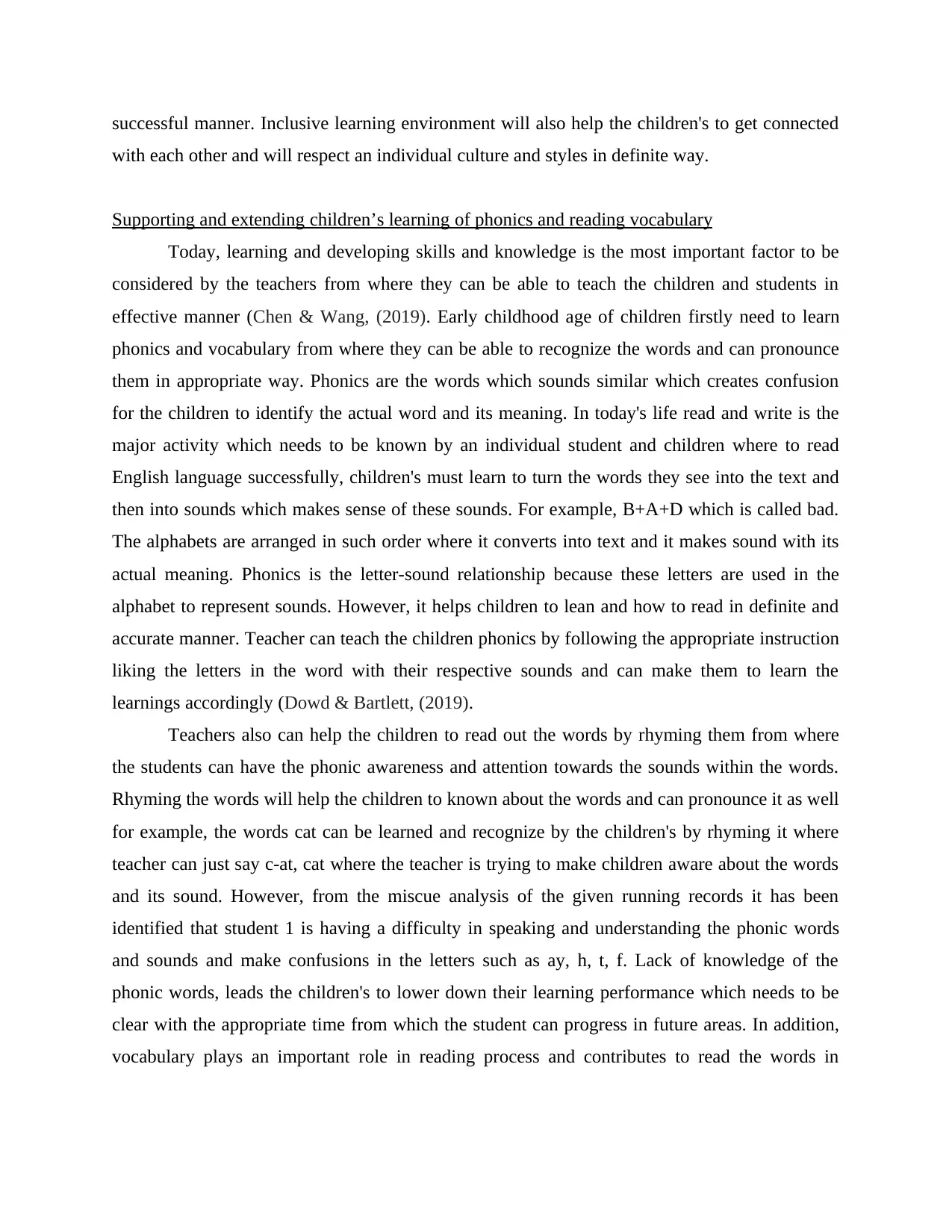
successful manner. Inclusive learning environment will also help the children's to get connected
with each other and will respect an individual culture and styles in definite way.
Supporting and extending children’s learning of phonics and reading vocabulary
Today, learning and developing skills and knowledge is the most important factor to be
considered by the teachers from where they can be able to teach the children and students in
effective manner (Chen & Wang, (2019). Early childhood age of children firstly need to learn
phonics and vocabulary from where they can be able to recognize the words and can pronounce
them in appropriate way. Phonics are the words which sounds similar which creates confusion
for the children to identify the actual word and its meaning. In today's life read and write is the
major activity which needs to be known by an individual student and children where to read
English language successfully, children's must learn to turn the words they see into the text and
then into sounds which makes sense of these sounds. For example, B+A+D which is called bad.
The alphabets are arranged in such order where it converts into text and it makes sound with its
actual meaning. Phonics is the letter-sound relationship because these letters are used in the
alphabet to represent sounds. However, it helps children to lean and how to read in definite and
accurate manner. Teacher can teach the children phonics by following the appropriate instruction
liking the letters in the word with their respective sounds and can make them to learn the
learnings accordingly (Dowd & Bartlett, (2019).
Teachers also can help the children to read out the words by rhyming them from where
the students can have the phonic awareness and attention towards the sounds within the words.
Rhyming the words will help the children to known about the words and can pronounce it as well
for example, the words cat can be learned and recognize by the children's by rhyming it where
teacher can just say c-at, cat where the teacher is trying to make children aware about the words
and its sound. However, from the miscue analysis of the given running records it has been
identified that student 1 is having a difficulty in speaking and understanding the phonic words
and sounds and make confusions in the letters such as ay, h, t, f. Lack of knowledge of the
phonic words, leads the children's to lower down their learning performance which needs to be
clear with the appropriate time from which the student can progress in future areas. In addition,
vocabulary plays an important role in reading process and contributes to read the words in
with each other and will respect an individual culture and styles in definite way.
Supporting and extending children’s learning of phonics and reading vocabulary
Today, learning and developing skills and knowledge is the most important factor to be
considered by the teachers from where they can be able to teach the children and students in
effective manner (Chen & Wang, (2019). Early childhood age of children firstly need to learn
phonics and vocabulary from where they can be able to recognize the words and can pronounce
them in appropriate way. Phonics are the words which sounds similar which creates confusion
for the children to identify the actual word and its meaning. In today's life read and write is the
major activity which needs to be known by an individual student and children where to read
English language successfully, children's must learn to turn the words they see into the text and
then into sounds which makes sense of these sounds. For example, B+A+D which is called bad.
The alphabets are arranged in such order where it converts into text and it makes sound with its
actual meaning. Phonics is the letter-sound relationship because these letters are used in the
alphabet to represent sounds. However, it helps children to lean and how to read in definite and
accurate manner. Teacher can teach the children phonics by following the appropriate instruction
liking the letters in the word with their respective sounds and can make them to learn the
learnings accordingly (Dowd & Bartlett, (2019).
Teachers also can help the children to read out the words by rhyming them from where
the students can have the phonic awareness and attention towards the sounds within the words.
Rhyming the words will help the children to known about the words and can pronounce it as well
for example, the words cat can be learned and recognize by the children's by rhyming it where
teacher can just say c-at, cat where the teacher is trying to make children aware about the words
and its sound. However, from the miscue analysis of the given running records it has been
identified that student 1 is having a difficulty in speaking and understanding the phonic words
and sounds and make confusions in the letters such as ay, h, t, f. Lack of knowledge of the
phonic words, leads the children's to lower down their learning performance which needs to be
clear with the appropriate time from which the student can progress in future areas. In addition,
vocabulary plays an important role in reading process and contributes to read the words in
⊘ This is a preview!⊘
Do you want full access?
Subscribe today to unlock all pages.

Trusted by 1+ million students worldwide
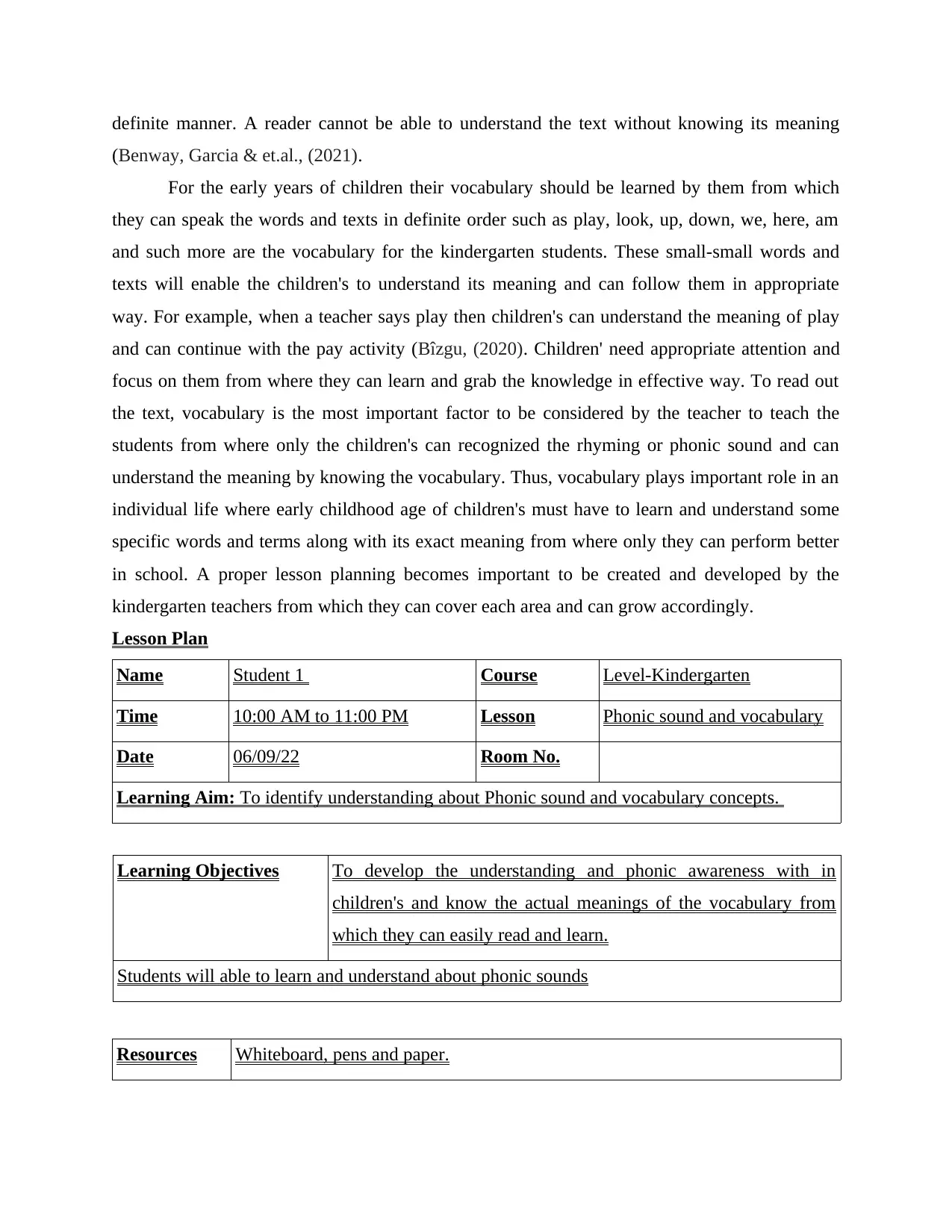
definite manner. A reader cannot be able to understand the text without knowing its meaning
(Benway, Garcia & et.al., (2021).
For the early years of children their vocabulary should be learned by them from which
they can speak the words and texts in definite order such as play, look, up, down, we, here, am
and such more are the vocabulary for the kindergarten students. These small-small words and
texts will enable the children's to understand its meaning and can follow them in appropriate
way. For example, when a teacher says play then children's can understand the meaning of play
and can continue with the pay activity (Bîzgu, (2020). Children' need appropriate attention and
focus on them from where they can learn and grab the knowledge in effective way. To read out
the text, vocabulary is the most important factor to be considered by the teacher to teach the
students from where only the children's can recognized the rhyming or phonic sound and can
understand the meaning by knowing the vocabulary. Thus, vocabulary plays important role in an
individual life where early childhood age of children's must have to learn and understand some
specific words and terms along with its exact meaning from where only they can perform better
in school. A proper lesson planning becomes important to be created and developed by the
kindergarten teachers from which they can cover each area and can grow accordingly.
Lesson Plan
Name Student 1 Course Level-Kindergarten
Time 10:00 AM to 11:00 PM Lesson Phonic sound and vocabulary
Date 06/09/22 Room No.
Learning Aim: To identify understanding about Phonic sound and vocabulary concepts.
Learning Objectives To develop the understanding and phonic awareness with in
children's and know the actual meanings of the vocabulary from
which they can easily read and learn.
Students will able to learn and understand about phonic sounds
Resources Whiteboard, pens and paper.
(Benway, Garcia & et.al., (2021).
For the early years of children their vocabulary should be learned by them from which
they can speak the words and texts in definite order such as play, look, up, down, we, here, am
and such more are the vocabulary for the kindergarten students. These small-small words and
texts will enable the children's to understand its meaning and can follow them in appropriate
way. For example, when a teacher says play then children's can understand the meaning of play
and can continue with the pay activity (Bîzgu, (2020). Children' need appropriate attention and
focus on them from where they can learn and grab the knowledge in effective way. To read out
the text, vocabulary is the most important factor to be considered by the teacher to teach the
students from where only the children's can recognized the rhyming or phonic sound and can
understand the meaning by knowing the vocabulary. Thus, vocabulary plays important role in an
individual life where early childhood age of children's must have to learn and understand some
specific words and terms along with its exact meaning from where only they can perform better
in school. A proper lesson planning becomes important to be created and developed by the
kindergarten teachers from which they can cover each area and can grow accordingly.
Lesson Plan
Name Student 1 Course Level-Kindergarten
Time 10:00 AM to 11:00 PM Lesson Phonic sound and vocabulary
Date 06/09/22 Room No.
Learning Aim: To identify understanding about Phonic sound and vocabulary concepts.
Learning Objectives To develop the understanding and phonic awareness with in
children's and know the actual meanings of the vocabulary from
which they can easily read and learn.
Students will able to learn and understand about phonic sounds
Resources Whiteboard, pens and paper.
Paraphrase This Document
Need a fresh take? Get an instant paraphrase of this document with our AI Paraphraser
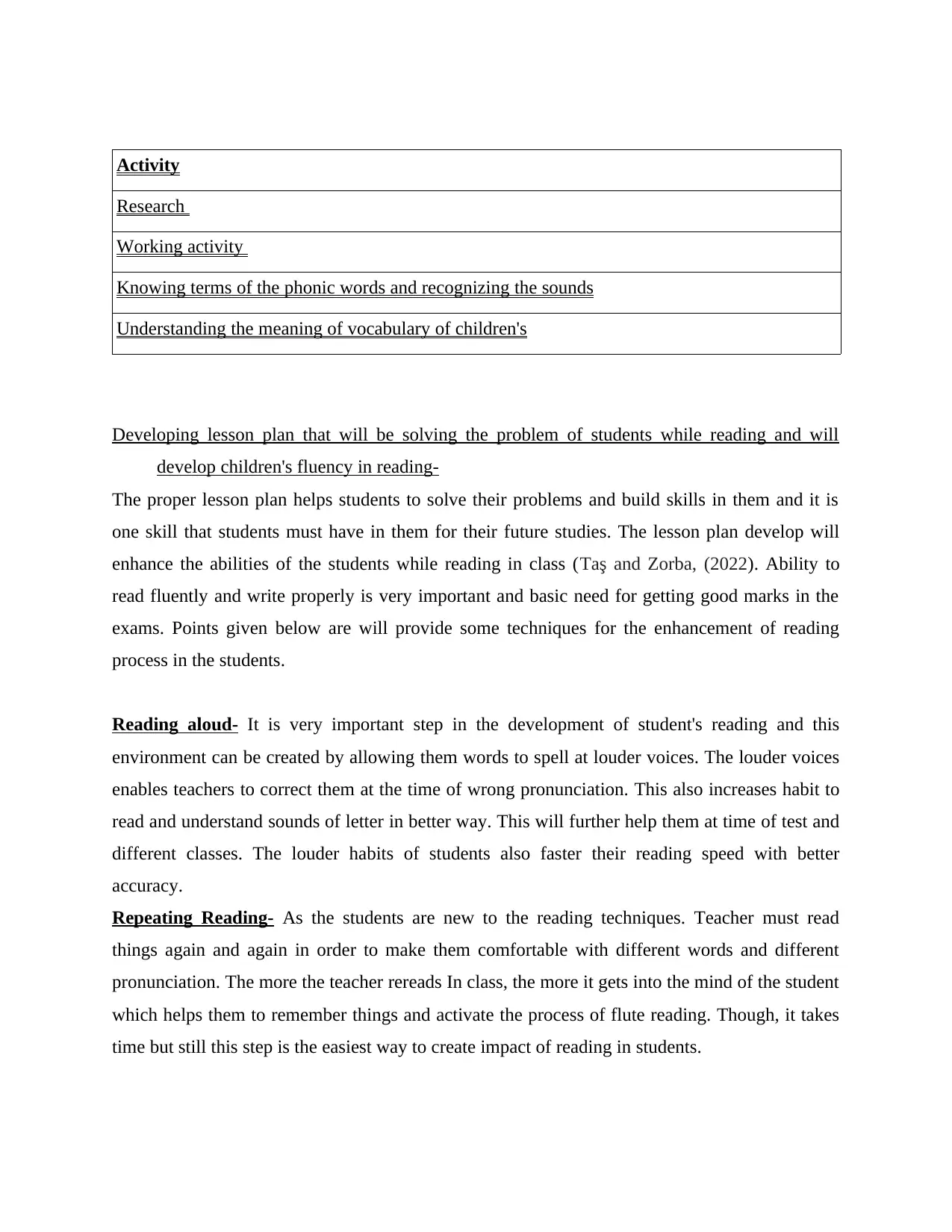
Activity
Research
Working activity
Knowing terms of the phonic words and recognizing the sounds
Understanding the meaning of vocabulary of children's
Developing lesson plan that will be solving the problem of students while reading and will
develop children's fluency in reading-
The proper lesson plan helps students to solve their problems and build skills in them and it is
one skill that students must have in them for their future studies. The lesson plan develop will
enhance the abilities of the students while reading in class (Taş and Zorba, (2022). Ability to
read fluently and write properly is very important and basic need for getting good marks in the
exams. Points given below are will provide some techniques for the enhancement of reading
process in the students.
Reading aloud- It is very important step in the development of student's reading and this
environment can be created by allowing them words to spell at louder voices. The louder voices
enables teachers to correct them at the time of wrong pronunciation. This also increases habit to
read and understand sounds of letter in better way. This will further help them at time of test and
different classes. The louder habits of students also faster their reading speed with better
accuracy.
Repeating Reading- As the students are new to the reading techniques. Teacher must read
things again and again in order to make them comfortable with different words and different
pronunciation. The more the teacher rereads In class, the more it gets into the mind of the student
which helps them to remember things and activate the process of flute reading. Though, it takes
time but still this step is the easiest way to create impact of reading in students.
Research
Working activity
Knowing terms of the phonic words and recognizing the sounds
Understanding the meaning of vocabulary of children's
Developing lesson plan that will be solving the problem of students while reading and will
develop children's fluency in reading-
The proper lesson plan helps students to solve their problems and build skills in them and it is
one skill that students must have in them for their future studies. The lesson plan develop will
enhance the abilities of the students while reading in class (Taş and Zorba, (2022). Ability to
read fluently and write properly is very important and basic need for getting good marks in the
exams. Points given below are will provide some techniques for the enhancement of reading
process in the students.
Reading aloud- It is very important step in the development of student's reading and this
environment can be created by allowing them words to spell at louder voices. The louder voices
enables teachers to correct them at the time of wrong pronunciation. This also increases habit to
read and understand sounds of letter in better way. This will further help them at time of test and
different classes. The louder habits of students also faster their reading speed with better
accuracy.
Repeating Reading- As the students are new to the reading techniques. Teacher must read
things again and again in order to make them comfortable with different words and different
pronunciation. The more the teacher rereads In class, the more it gets into the mind of the student
which helps them to remember things and activate the process of flute reading. Though, it takes
time but still this step is the easiest way to create impact of reading in students.
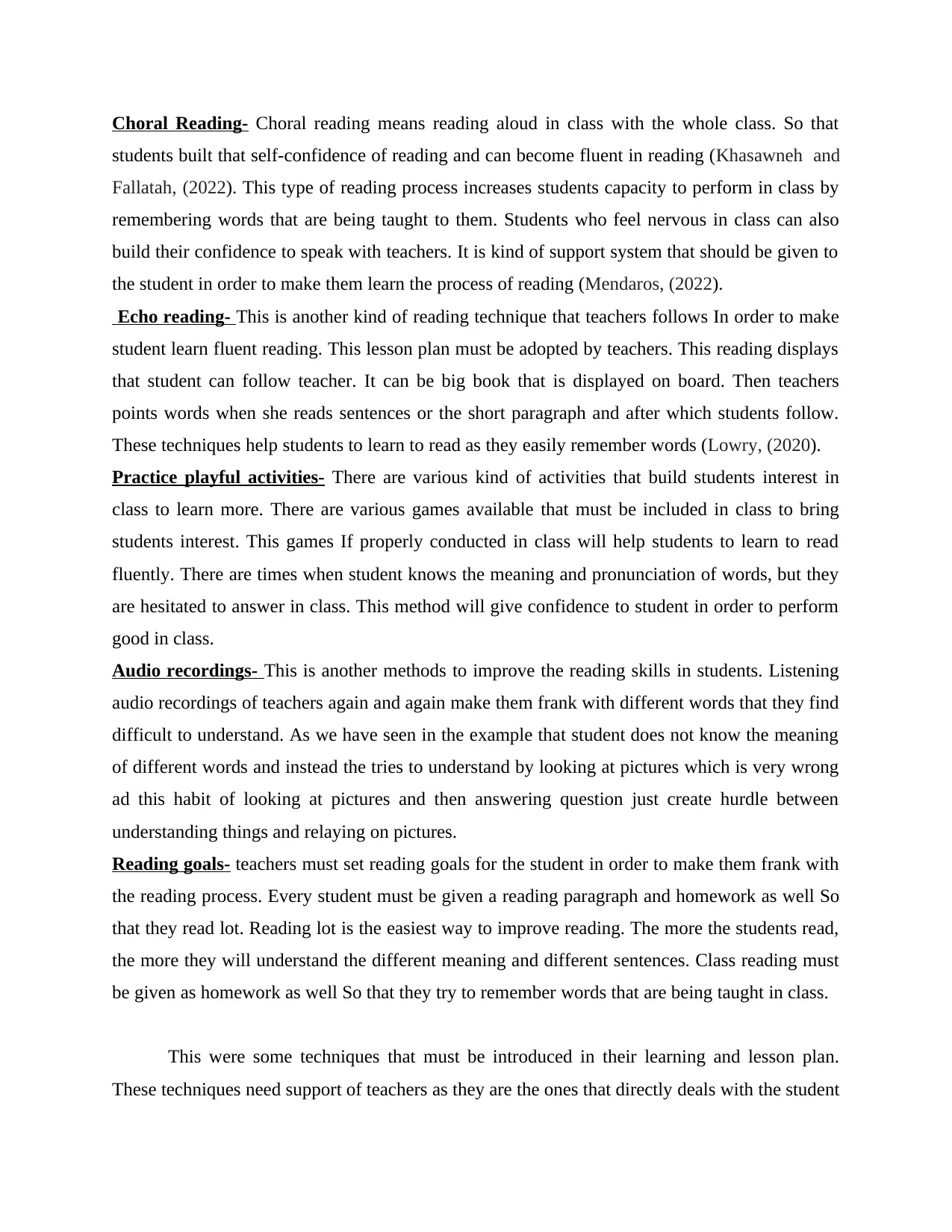
Choral Reading- Choral reading means reading aloud in class with the whole class. So that
students built that self-confidence of reading and can become fluent in reading (Khasawneh and
Fallatah, (2022). This type of reading process increases students capacity to perform in class by
remembering words that are being taught to them. Students who feel nervous in class can also
build their confidence to speak with teachers. It is kind of support system that should be given to
the student in order to make them learn the process of reading (Mendaros, (2022).
Echo reading- This is another kind of reading technique that teachers follows In order to make
student learn fluent reading. This lesson plan must be adopted by teachers. This reading displays
that student can follow teacher. It can be big book that is displayed on board. Then teachers
points words when she reads sentences or the short paragraph and after which students follow.
These techniques help students to learn to read as they easily remember words (Lowry, (2020).
Practice playful activities- There are various kind of activities that build students interest in
class to learn more. There are various games available that must be included in class to bring
students interest. This games If properly conducted in class will help students to learn to read
fluently. There are times when student knows the meaning and pronunciation of words, but they
are hesitated to answer in class. This method will give confidence to student in order to perform
good in class.
Audio recordings- This is another methods to improve the reading skills in students. Listening
audio recordings of teachers again and again make them frank with different words that they find
difficult to understand. As we have seen in the example that student does not know the meaning
of different words and instead the tries to understand by looking at pictures which is very wrong
ad this habit of looking at pictures and then answering question just create hurdle between
understanding things and relaying on pictures.
Reading goals- teachers must set reading goals for the student in order to make them frank with
the reading process. Every student must be given a reading paragraph and homework as well So
that they read lot. Reading lot is the easiest way to improve reading. The more the students read,
the more they will understand the different meaning and different sentences. Class reading must
be given as homework as well So that they try to remember words that are being taught in class.
This were some techniques that must be introduced in their learning and lesson plan.
These techniques need support of teachers as they are the ones that directly deals with the student
students built that self-confidence of reading and can become fluent in reading (Khasawneh and
Fallatah, (2022). This type of reading process increases students capacity to perform in class by
remembering words that are being taught to them. Students who feel nervous in class can also
build their confidence to speak with teachers. It is kind of support system that should be given to
the student in order to make them learn the process of reading (Mendaros, (2022).
Echo reading- This is another kind of reading technique that teachers follows In order to make
student learn fluent reading. This lesson plan must be adopted by teachers. This reading displays
that student can follow teacher. It can be big book that is displayed on board. Then teachers
points words when she reads sentences or the short paragraph and after which students follow.
These techniques help students to learn to read as they easily remember words (Lowry, (2020).
Practice playful activities- There are various kind of activities that build students interest in
class to learn more. There are various games available that must be included in class to bring
students interest. This games If properly conducted in class will help students to learn to read
fluently. There are times when student knows the meaning and pronunciation of words, but they
are hesitated to answer in class. This method will give confidence to student in order to perform
good in class.
Audio recordings- This is another methods to improve the reading skills in students. Listening
audio recordings of teachers again and again make them frank with different words that they find
difficult to understand. As we have seen in the example that student does not know the meaning
of different words and instead the tries to understand by looking at pictures which is very wrong
ad this habit of looking at pictures and then answering question just create hurdle between
understanding things and relaying on pictures.
Reading goals- teachers must set reading goals for the student in order to make them frank with
the reading process. Every student must be given a reading paragraph and homework as well So
that they read lot. Reading lot is the easiest way to improve reading. The more the students read,
the more they will understand the different meaning and different sentences. Class reading must
be given as homework as well So that they try to remember words that are being taught in class.
This were some techniques that must be introduced in their learning and lesson plan.
These techniques need support of teachers as they are the ones that directly deals with the student
⊘ This is a preview!⊘
Do you want full access?
Subscribe today to unlock all pages.

Trusted by 1+ million students worldwide
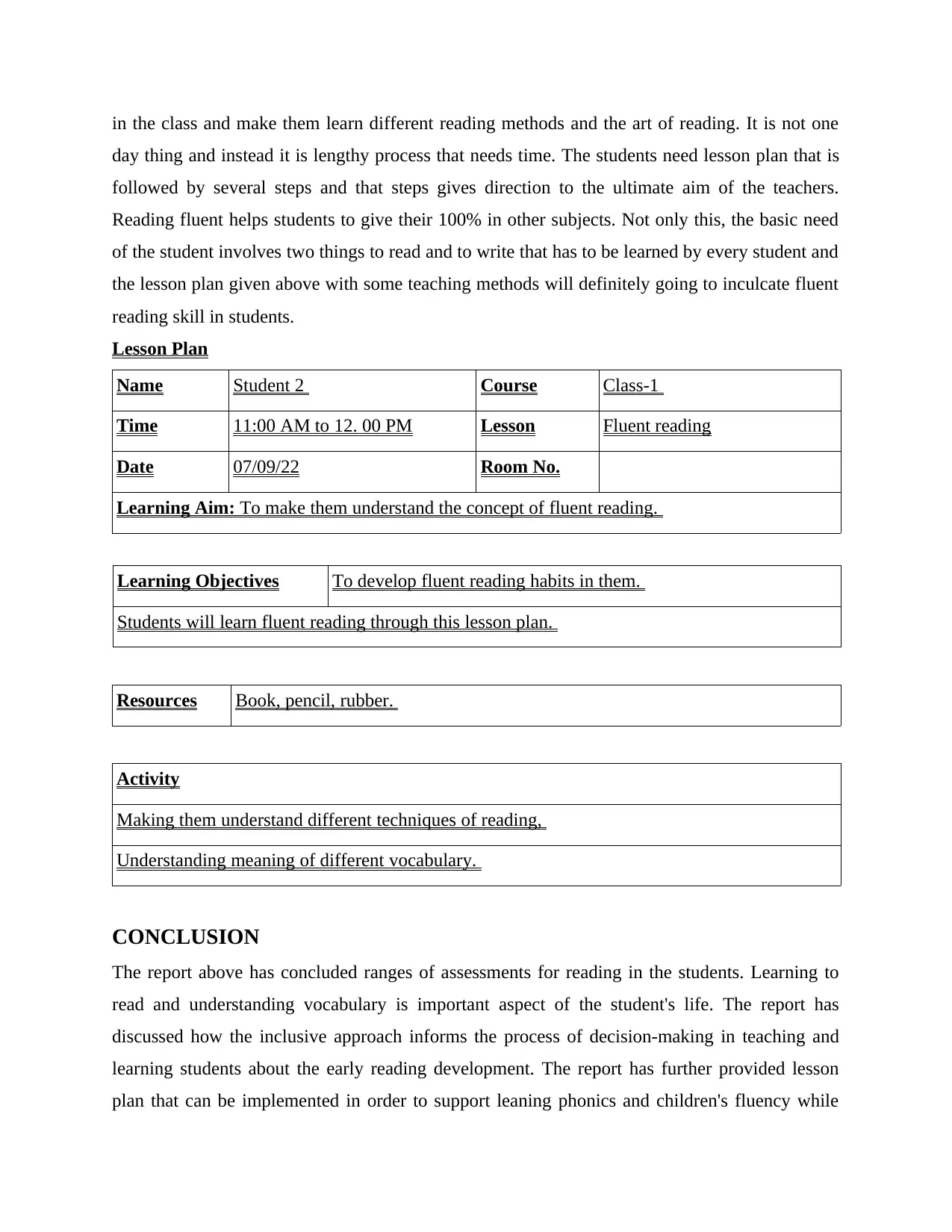
in the class and make them learn different reading methods and the art of reading. It is not one
day thing and instead it is lengthy process that needs time. The students need lesson plan that is
followed by several steps and that steps gives direction to the ultimate aim of the teachers.
Reading fluent helps students to give their 100% in other subjects. Not only this, the basic need
of the student involves two things to read and to write that has to be learned by every student and
the lesson plan given above with some teaching methods will definitely going to inculcate fluent
reading skill in students.
Lesson Plan
Name Student 2 Course Class-1
Time 11:00 AM to 12. 00 PM Lesson Fluent reading
Date 07/09/22 Room No.
Learning Aim: To make them understand the concept of fluent reading.
Learning Objectives To develop fluent reading habits in them.
Students will learn fluent reading through this lesson plan.
Resources Book, pencil, rubber.
Activity
Making them understand different techniques of reading,
Understanding meaning of different vocabulary.
CONCLUSION
The report above has concluded ranges of assessments for reading in the students. Learning to
read and understanding vocabulary is important aspect of the student's life. The report has
discussed how the inclusive approach informs the process of decision-making in teaching and
learning students about the early reading development. The report has further provided lesson
plan that can be implemented in order to support leaning phonics and children's fluency while
day thing and instead it is lengthy process that needs time. The students need lesson plan that is
followed by several steps and that steps gives direction to the ultimate aim of the teachers.
Reading fluent helps students to give their 100% in other subjects. Not only this, the basic need
of the student involves two things to read and to write that has to be learned by every student and
the lesson plan given above with some teaching methods will definitely going to inculcate fluent
reading skill in students.
Lesson Plan
Name Student 2 Course Class-1
Time 11:00 AM to 12. 00 PM Lesson Fluent reading
Date 07/09/22 Room No.
Learning Aim: To make them understand the concept of fluent reading.
Learning Objectives To develop fluent reading habits in them.
Students will learn fluent reading through this lesson plan.
Resources Book, pencil, rubber.
Activity
Making them understand different techniques of reading,
Understanding meaning of different vocabulary.
CONCLUSION
The report above has concluded ranges of assessments for reading in the students. Learning to
read and understanding vocabulary is important aspect of the student's life. The report has
discussed how the inclusive approach informs the process of decision-making in teaching and
learning students about the early reading development. The report has further provided lesson
plan that can be implemented in order to support leaning phonics and children's fluency while
Paraphrase This Document
Need a fresh take? Get an instant paraphrase of this document with our AI Paraphraser

reading and reading comprehensions. The lesson plan If implemented properly by the teachers
will develop student's skill that help them to get good marks in the exam as well.
will develop student's skill that help them to get good marks in the exam as well.
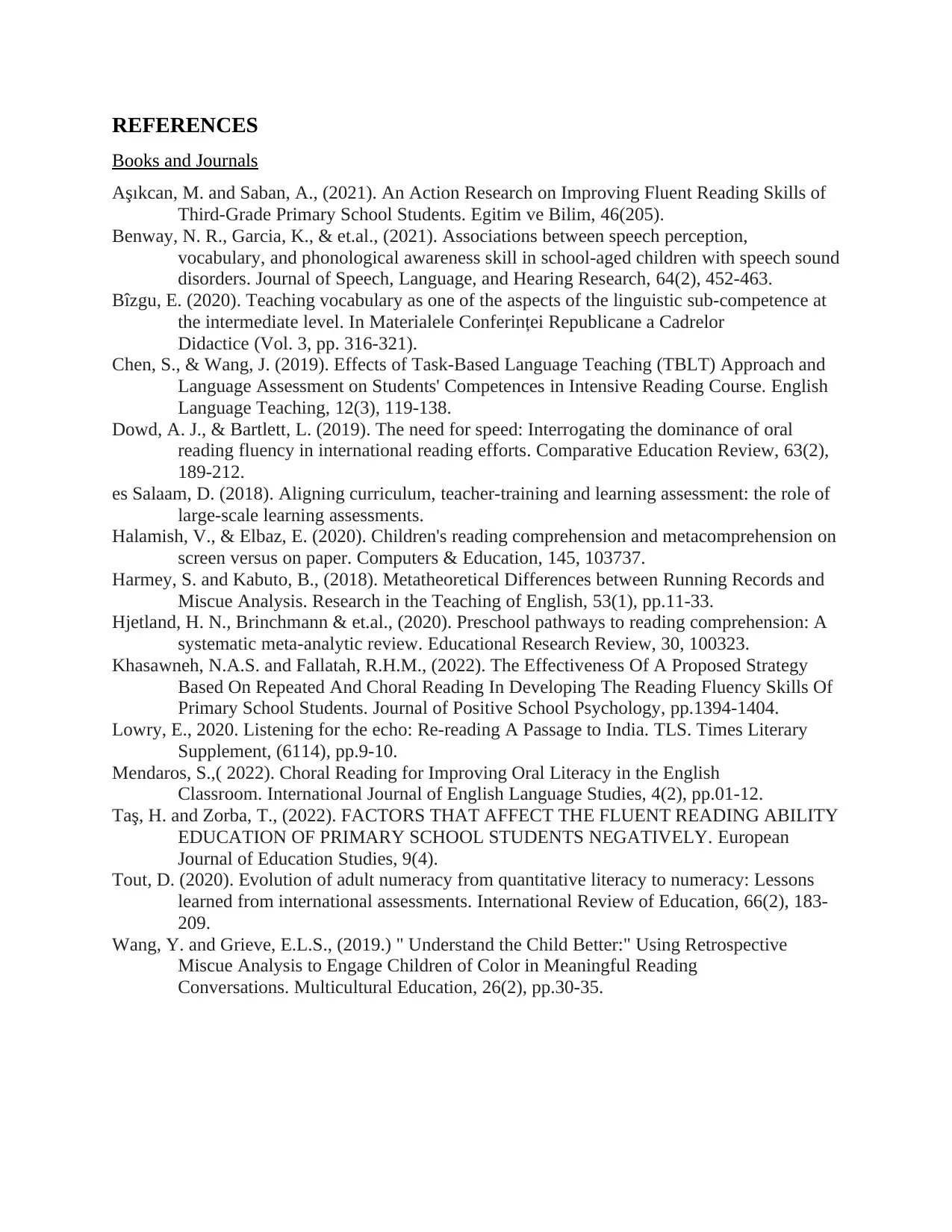
REFERENCES
Books and Journals
Aşıkcan, M. and Saban, A., (2021). An Action Research on Improving Fluent Reading Skills of
Third-Grade Primary School Students. Egitim ve Bilim, 46(205).
Benway, N. R., Garcia, K., & et.al., (2021). Associations between speech perception,
vocabulary, and phonological awareness skill in school-aged children with speech sound
disorders. Journal of Speech, Language, and Hearing Research, 64(2), 452-463.
Bîzgu, E. (2020). Teaching vocabulary as one of the aspects of the linguistic sub-competence at
the intermediate level. In Materialele Conferinței Republicane a Cadrelor
Didactice (Vol. 3, pp. 316-321).
Chen, S., & Wang, J. (2019). Effects of Task-Based Language Teaching (TBLT) Approach and
Language Assessment on Students' Competences in Intensive Reading Course. English
Language Teaching, 12(3), 119-138.
Dowd, A. J., & Bartlett, L. (2019). The need for speed: Interrogating the dominance of oral
reading fluency in international reading efforts. Comparative Education Review, 63(2),
189-212.
es Salaam, D. (2018). Aligning curriculum, teacher‐training and learning assessment: the role of
large‐scale learning assessments.
Halamish, V., & Elbaz, E. (2020). Children's reading comprehension and metacomprehension on
screen versus on paper. Computers & Education, 145, 103737.
Harmey, S. and Kabuto, B., (2018). Metatheoretical Differences between Running Records and
Miscue Analysis. Research in the Teaching of English, 53(1), pp.11-33.
Hjetland, H. N., Brinchmann & et.al., (2020). Preschool pathways to reading comprehension: A
systematic meta-analytic review. Educational Research Review, 30, 100323.
Khasawneh, N.A.S. and Fallatah, R.H.M., (2022). The Effectiveness Of A Proposed Strategy
Based On Repeated And Choral Reading In Developing The Reading Fluency Skills Of
Primary School Students. Journal of Positive School Psychology, pp.1394-1404.
Lowry, E., 2020. Listening for the echo: Re-reading A Passage to India. TLS. Times Literary
Supplement, (6114), pp.9-10.
Mendaros, S.,( 2022). Choral Reading for Improving Oral Literacy in the English
Classroom. International Journal of English Language Studies, 4(2), pp.01-12.
Taş, H. and Zorba, T., (2022). FACTORS THAT AFFECT THE FLUENT READING ABILITY
EDUCATION OF PRIMARY SCHOOL STUDENTS NEGATIVELY. European
Journal of Education Studies, 9(4).
Tout, D. (2020). Evolution of adult numeracy from quantitative literacy to numeracy: Lessons
learned from international assessments. International Review of Education, 66(2), 183-
209.
Wang, Y. and Grieve, E.L.S., (2019.) " Understand the Child Better:" Using Retrospective
Miscue Analysis to Engage Children of Color in Meaningful Reading
Conversations. Multicultural Education, 26(2), pp.30-35.
Books and Journals
Aşıkcan, M. and Saban, A., (2021). An Action Research on Improving Fluent Reading Skills of
Third-Grade Primary School Students. Egitim ve Bilim, 46(205).
Benway, N. R., Garcia, K., & et.al., (2021). Associations between speech perception,
vocabulary, and phonological awareness skill in school-aged children with speech sound
disorders. Journal of Speech, Language, and Hearing Research, 64(2), 452-463.
Bîzgu, E. (2020). Teaching vocabulary as one of the aspects of the linguistic sub-competence at
the intermediate level. In Materialele Conferinței Republicane a Cadrelor
Didactice (Vol. 3, pp. 316-321).
Chen, S., & Wang, J. (2019). Effects of Task-Based Language Teaching (TBLT) Approach and
Language Assessment on Students' Competences in Intensive Reading Course. English
Language Teaching, 12(3), 119-138.
Dowd, A. J., & Bartlett, L. (2019). The need for speed: Interrogating the dominance of oral
reading fluency in international reading efforts. Comparative Education Review, 63(2),
189-212.
es Salaam, D. (2018). Aligning curriculum, teacher‐training and learning assessment: the role of
large‐scale learning assessments.
Halamish, V., & Elbaz, E. (2020). Children's reading comprehension and metacomprehension on
screen versus on paper. Computers & Education, 145, 103737.
Harmey, S. and Kabuto, B., (2018). Metatheoretical Differences between Running Records and
Miscue Analysis. Research in the Teaching of English, 53(1), pp.11-33.
Hjetland, H. N., Brinchmann & et.al., (2020). Preschool pathways to reading comprehension: A
systematic meta-analytic review. Educational Research Review, 30, 100323.
Khasawneh, N.A.S. and Fallatah, R.H.M., (2022). The Effectiveness Of A Proposed Strategy
Based On Repeated And Choral Reading In Developing The Reading Fluency Skills Of
Primary School Students. Journal of Positive School Psychology, pp.1394-1404.
Lowry, E., 2020. Listening for the echo: Re-reading A Passage to India. TLS. Times Literary
Supplement, (6114), pp.9-10.
Mendaros, S.,( 2022). Choral Reading for Improving Oral Literacy in the English
Classroom. International Journal of English Language Studies, 4(2), pp.01-12.
Taş, H. and Zorba, T., (2022). FACTORS THAT AFFECT THE FLUENT READING ABILITY
EDUCATION OF PRIMARY SCHOOL STUDENTS NEGATIVELY. European
Journal of Education Studies, 9(4).
Tout, D. (2020). Evolution of adult numeracy from quantitative literacy to numeracy: Lessons
learned from international assessments. International Review of Education, 66(2), 183-
209.
Wang, Y. and Grieve, E.L.S., (2019.) " Understand the Child Better:" Using Retrospective
Miscue Analysis to Engage Children of Color in Meaningful Reading
Conversations. Multicultural Education, 26(2), pp.30-35.
⊘ This is a preview!⊘
Do you want full access?
Subscribe today to unlock all pages.

Trusted by 1+ million students worldwide
1 out of 12
Related Documents
Your All-in-One AI-Powered Toolkit for Academic Success.
+13062052269
info@desklib.com
Available 24*7 on WhatsApp / Email
![[object Object]](/_next/static/media/star-bottom.7253800d.svg)
Unlock your academic potential
Copyright © 2020–2025 A2Z Services. All Rights Reserved. Developed and managed by ZUCOL.





